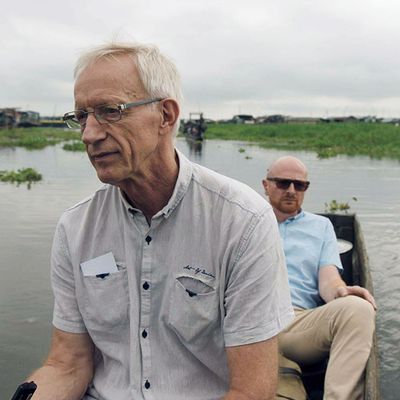
A tricked-up documentary like Cold Case Hammarskjöld reminds you that conspiracy theories make for great yarns. They have beginnings, middles, and ends. They give multi-determined tragedies a clean historical arc. They cater to the idea that, as often as not, We Want to Believe. I can’t entirely vouch for the Danish director and TV host Mads Brügger’s new film, but I’m thrilled that it’s out there. People have died trying to tell this story, or appear to have died. There are photos and testimonies, and the trajectory as a whole makes terrible sense. I want to believe.
The film chronicles Brügger’s six-year journey alongside Swedish private investigator Göran Björkdahl to get to the bottom of the suspicious 1961 plane crash in Zambia (then Northern Rhodesia) that killed United Nations secretary-general (and human-rights activist) Dag Hammarskjöld. The crash was initially blamed on pilot error during the plane’s descent, but the pilot’s chief error, Brügger and Björkdahl suggest, was taking off with a bomb onboard. His other error was failing to dodge bullets from a second plane (flown by an ex–Royal Air Force pilot) when said bomb didn’t explode. The bomb might ultimately have exploded, but eyewitnesses — being black — weren’t given credence by white authorities and the plane was buried more or less where it crashed. Brügger — who is on camera for much of the film — presents his bemused Swedish partner with a pair of shovels, pith helmets, and Cuban cigars and heads to recover the wreckage. I’m not sure how far they’d have gotten with shovels, but Zambian authorities get wind and put the kibosh on their digging.
The juxtaposition of gonzo high jinks and gruesome photos of Hammarskjöld’s body is awkward. To love Cold Case Hammarskjöld as much as I do, you have to get past what a friend calls the director’s “douchiness.” Brügger leads with his meta, admitting midway through that he doesn’t entirely trust his story and has had to resort to a framing device and cartoon inserts. The inserts are useful, the framing device not so. His gimmick is to film himself in a Congolese hotel room, dictating the story of his and Björkdahl’s search to two black women typists employed singly but with their footage intercut. At various junctures, each turns from her manual typewriter and asks Brügger for clarification or offers an opinion. When the story veers in another direction — toward a conspiracy fueled in part by white-supremacist goals — the director holds on their shocked faces.
I’d have deep-sixed those scenes, not just because they’re weirdly patronizing but because the story itself — the twisty investigation that takes Brügger and Björkdahl all over Africa and Europe — turns out to be so blood-freezing, and Brügger doesn’t need African women to validate the horror. Evidence of the conspiracy builds and branches out, finally settling at the doorstep of a paramilitary organization staffed with white mercenaries who allegedly committed crimes even more grotesque and far-reaching than the murder of Hammarskjöld. The shadow militia goes by the name of the South African Institute for Maritime Research (SAIMR), and footage of Desmond Tutu and his colleagues noting its existence during South Africa’s Truth and Reconciliation Commission in the late ’90s proves it’s not just the province of tinfoil-hatters.
A lot of acronyms get thrown in the air, among them MI6 and CIA. That both organizations had connections to plots to destabilize newly independent African countries is by now beyond dispute, but the individuals and organizations that were tasked with carrying out the agenda have largely remained hidden — or been refracted through the lenses of John Le Carré, Frederick Forsyth, Robert Ludlum, et al. Now Brügger gives us a name: Keith Maxwell, who dresses only in white and attends formal dinners in 18th-century naval-commodore outfits with tricornered hats. He is by all reports a lively and companionable fellow with plenty of stories about operations like the one that finished off Hammarskjöld, and he will kill you without hesitation if he perceives you as a threat. A rising young SAIMR employee named Dagmar Feil learned this the hard way in the ’90s when she tried to bring some of the organization’s practices to light. But Feil’s unsolved stabbing death might also have driven the increasingly mad Maxwell to share his story in the form of a wild, semi-coherent memoir.
Cold Case Hammarskjöld finally comes down to an ex-SAIMR employee named Alexander Jones, who holds the screen for much of the last act. If Jones is lying about himself, Maxwell, Feil, and a genocidal agenda that was run (he believes) from England, then he’s the most credible liar I’ve ever seen. “I need personal closure,” he says, but this is not a dramatic monologue. He answers questions simply, evenly, without histrionics. His testimony marks the close of Cold Case Hammarskjöld but might well be the beginning of the next cold case, which will encompass the history of postcolonial Africa and even — this is the film’s most jaw-dropping charge — the spread of AIDS via so-called philanthropic clinics. Was the potential for increased control by black Africans over their own resources the impetus for Hammarskjöld’s killing way back in 1961?
If, like so many conspiracy-mongers, Brügger is in this to make his name, whatever the social consequences, his comeuppance should be swift. But I want to believe that this isn’t a stunt and that his first-person meta nonsense — his desire to call attention to his floundering — is a sign of honesty, not obscurantism. He wants to share his process with us to remind us that, nowadays, we’re all engaged in the work of separating false conspiracies from true ones. Maybe that jokey shovel sequence can be taken as a metaphor: I have done my modest digging; now it’s time to bring in the earthmovers.
*This article appears in the August 5, 2019, issue of New York Magazine. Subscribe Now!


